The 2024 AstraZeneca prize in synthetic chemistry has been awarded to Ruth Webster, University of Cambridge, for her productive early career and innovative research, particularly in iron catalysis, which is useful to both discovery and development chemists at AstraZeneca.

The Webster group’s approach to iron catalysis is to use simple, ligated systems. They try to avoid the use of phosphine ligands, instead opting for ligands that are inexpensive, scalable and have flexibility in terms of steric and electronic tuning. Salen and β-diketiminate ligands have been used widely by the group and are formed on a multigram scale through simple condensation reactions. Although less well-known to the organic community, β-diketiminates allow the synthesis of low coordinate and thus highly active iron pre-catalysts. Salen ligands are well-known in enantioselective epoxidation chemistry with Cr and Mn but have received less attention of late, and are not well-explored with iron.
The group’s approach to catalyst design aligns well with the key tenets of sustainable catalysis, with mechanistic understanding allowing the group to tailor their catalysis through ligand design. A ligated system offers many benefits over an iron salt, not least solubility, but also the opportunity to use very low loadings of catalyst. For example, their work with salen ligands employs 0.5 to 2 mol% iron pre-catalyst, which is contrary to a perceived drawback of iron chemistry that high loadings are assumed necessary.
A recent collaboration between AstraZeneca and Webster, in the form of an iCASE award, tied together several of these key goals. Culminating in a published paper,1 the work highlights this much needed holistic approach to modern synthetic chemistry, and hence the award of the 2024 AstraZeneca UK chemistry prize to Webster.
it may be this ‘prediction first’ approach can act as a roadmap for those with challenging transformations in hand
Ruth Webster
‘Working closely with the early chemical development team along with collaborators with expertise in electron paramagnetic resonance spectroscopy and density functional theory (DFT) calculations (Emma Richards, Cardiff, and Vera Krewald, Darmstadt, respectively), the team were able to shed light on an incredibly complex set of interlinked catalytic cycles,’ explains Webster. ‘This was supported by advanced mass spectrometry techniques that gave evidence for an elusive intermediate, which was only possible through collaboration with Ian Fairlamb and Karl Heaton at the University of York.’
The catalyst employed was an air-stable iron complex but paramagnetism necessitated a multi-pronged approach. Webster notes that ‘looking forward, if we are to replace or have more sustainable, first row, transition metals compete with the precious metals, our understanding of such paramagnetic systems needs to deepen.’
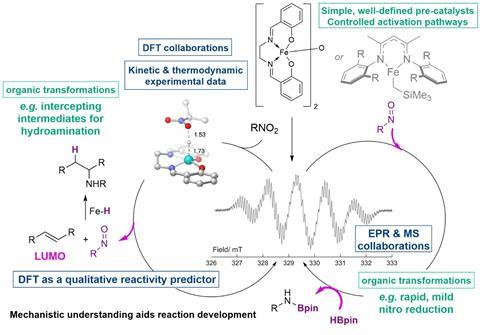
The team also used predictive but simple DFT calculations to guide synthesis. Using Lumo energy calculations, which took minutes to run, the team were able to provide a qualitative reactivity guide across a series of alkenes. Webster continues that ‘this in silico, predictive approach is something we need to adopt more widely. Rather than undertake hundreds of wasteful failed reactions, understanding key steps in a mechanism and predicting likelihood of success is a method that could be more widely adopted and we see this as the culmination of a high-quality academia-industry collaboration. Indeed, it may be this “prediction first” approach can act as a roadmap for those with challenging transformations in hand.’ In line with this, in situ reaction monitoring is ued to identify reaction intermediates and catalyst resting states.
The development of efficient, novel, sustainable chemistry aligns with AstraZeneca’s goals. Furthermore, the increasing complexity and diversity of active pharmaceutical ingredients (APIs) means that it is ever more important that there is continued expansion and understanding of the synthetic chemistry toolbox.2 AstraZeneca believes the continued collaboration with academia to develop innovative approaches and technologies is important to support effective future delivery, whilst reducing the environmental impact.
Support of and close collaborations with academia are critical to the continued development of these new synthetic methods
Mike Nunn
Development of new medicines is a challenging process requiring large numbers of scientists across the development cycle. AstraZeneca’s response to this is to implement new ideas as soon as possible to maximise the opportunities to iterate and improve processes. Therefore, having a range of novel and innovative synthetic methods to support discovery, development and commercial launch is key.

While continuing to develop new molecular entities, AstraZeneca’s sustainability targets also require the application of new techniques to reduce waste across the supply chain. Expansion in the use of high throughput experimentation provides the opportunity to decrease the quantities of material (and the subsequent waste) required to develop a route to manufacture an API. Predictive and in silico modelling are important tools that may facilitate more focused and rapid synthetic development but they require an array of skill sets to achieve these goals.
Mike Nunn, a principal scientist in early chemical development at AstraZeneca, explains that throughout the API supply chain, a reduction in the use of high environmental impact materials and replacing precious metal-catalysed processes with base-metal catalysis or biocatalysis are areas that continue to require significant research. ‘Support of and close collaborations with academia are critical to the continued development of these new synthetic methods.’
New frontiers in synthetic chemistry 2024
Including Ruth Webster as a speaker, this symposium will showcase recent advances from across synthetic chemistry and discuss what future developments may be in store for the field by bringing together researchers across several career stages from both academia and industry.
Supporting the next generation of scientists is an important part of planning for the future. Nunn continues that ‘at AstraZeneca, we are proud of our continued support of students from apprenticeships through undergraduate industrial placements and PhD studentships to help with the education of future generations of scientists. Continuous development at AstraZeneca is an equally important part of the role and collaborations with academic groups provide our scientists opportunities to discuss, influence and learn about science outside of their day-to-day activities while expanding their networks.’
Ruth Webster is an assistant professor at the University of Cambridge and Mike Nunn works in research and development at AstraZeneca.
References
1 Pocock et al J. Am. Chem. Soc. 2024, 146, 19839−19851 (DOI: 10.1021/jacs.4c02797)
2 Karageorgis et al, Org. Process Res. Dev. 2024, 28, 3339−3346 (DOI: 10.1021/acs.oprd.4c00224)




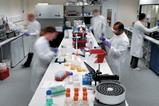
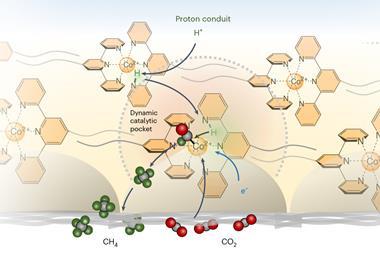








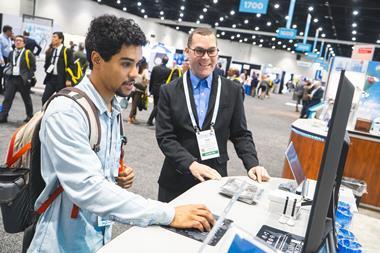
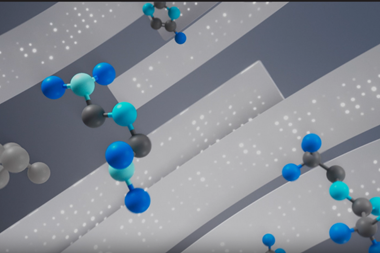

No comments yet